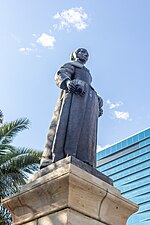1 Thibault Square

1 Thibault Square, formally known as the LG Building and originally known as the "BP Centre", is a 126.5-metre (415 ft) modernist skyscraper on the European-style Thibault Square at the end of St George's Mall, Cape Town, South Africa.Work on the building began in 1969 and was completed in 1972. As of 2019 it is the second tallest building in Cape Town. The 34-degree diagonal twist, which puts it on a north–south axis, reduces sun loads on the façades, thereby reducing pressure on the air-conditioning system. To further shield the façades, a pre-cast screen is mounted on every floor, allowing good air flow and cutting off direct sun rays. This unique orientation also means that all the offices have views of either the mountain or the harbour, and that none stare straight into the façades of the surrounding buildings.At 11:55pm on October 1989 a bomb exploded outside the building causing no casualties or injuries.In 2006 the building was sold along with two other office buildings in Cape Town for R300 million and was at the time the largest Grade A commercial property in the city.Flanked by John Skotness' Mythological Landscape steel-and-bronze sculpture, the piazza below is a popular public space for office workers and visitors to the city. The building provides a focal point for Thibault Square.In 2008 the building was acknowledged in a national survey by the South African Institute of Architects to be one of the country's "good buildings".
Excerpt from the Wikipedia article 1 Thibault Square (License: CC BY-SA 3.0, Authors, Images).1 Thibault Square
Long Street, Cape Town Cape Town Ward 115
Geographical coordinates (GPS) Address External links Nearby Places Show on map
Geographical coordinates (GPS)
| Latitude | Longitude |
|---|---|
| N -33.918888888889 ° | E 18.423333333333 ° |
Address
1 Thibault Square (British Petroleum Centre)
Long Street 1
8000 Cape Town, Cape Town Ward 115
Western Cape, South Africa
Open on Google Maps









